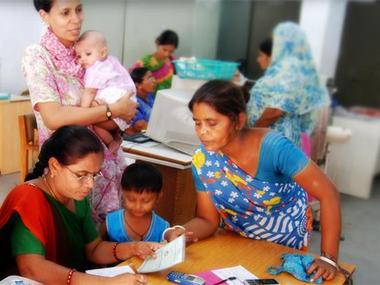The year is due to end, and the
report card for India’s flagship financial inclusion programme, the Pradhan Mantri Jan Dhan Yojana for 2018 is out. Before diving into the specifics of the programme, it would be useful to remember that the year has been revelatory with regard to women’s issues, from the #MeToo movement to the
217 years that it will apparently take to close the gender pay gap. In this context, it is important to understand why the Jan Dhan Yojana is such an important scheme, and how it is underpinned by the limitations put on women because of societal hindrances, including gender violence, limited mobility, not being allowed to work, etc. These challenges women face extend particularly to access to finance, resulting in women relying heavily on informal channels to borrow and save, such as friends, family or self-help groups, and the lack of resources and capacities to create wealth. What has been done so far In this context, it is instructive to note that the
state-wise statistics reveal the geographic discrimination embedded into the narrative of financial inclusion in our country. This is proved by the fact that the beneficiaries are considerably fewer in a number of states in the North East and the Andaman and Nicobar islands. [caption id=“attachment_4226283” align=“alignleft” width=“380”] Representational image.[/caption] Even though the statistics of the gender split in the accounts opened have not been revealed, the number of households covered in most states appears to be 100 percent. But before we rejoice over “complete” financial inclusion in India, it would be relevant to note that the coverage of households rather than individuals seeks to make women invisible, even though this is an improvement over the previous Swabhimaan scheme that targeted villages. This is important because women specifically score disproportionately low on ordinary functions like savings and borrowings, savings particularly through banks formally. This policy of gender neutrality prohibits advancing women’s financial inclusion. A better example is that of
Nepal, where it was found that offering easily accessible, no-fee accounts to female heads of households in slums resulted in 84 percent of women opening an account and 80 percent making at least two deposits in the first year. Furthermore, even though an overdraft facility of Rs 5,000 is available per household targeting women in particular, there is no express guideline to banks stating so. Additionally, in the absence of IDs/documentation, there is lack of clarity over how banks classify individuals as “low risk” to open an account. It would also be pertinent to note that the scheme does not consider other socially relevant factors, such as caste, tribal status and geographical disparity, for “priority lending”. This is particularly important because the factor of gender gets increasingly compounded when combined with other limiting parameters of caste, geography, tribal status, etc. Perhaps the biggest failure of the Jan Dhan scheme in being gender inclusive is asking for information in the gender binary of male and female, clearly violating the
Supreme Court’s 2014 judgment, which directed the Centre and state governments to grant legal recognition to the third gender as a gender identity. The lack of adequate gender-specific data, in terms of usage of accounts by women, duplication of accounts and dormancy, has also been an impediment to crafting more efficient financial inclusion schemes for women. The evidence on wider inclusion — beyond opening bank accounts — or the lack of it, has been disappointing. Moreover, in the design of such policies, lack of imagination has been a significant hurdle. We continue to peg financial inclusion to the formal saving mechanisms of banks, instead of also tapping into informal modes of savings, relying on the actual lived experiences of women trying to traverse the complicated and intimidating financial structures of our country. Consider, for example, the application form of the Jan Suraksha scheme, which requires individuals to possess a savings bank account and a mobile number. Also, the access points for these schemes are only about 6,00,000 agents for a population of over 1 billion people, with no specific strategy to reach women. What can be done differently Using data: A more meaningful foray into financial inclusion will be to drive specific gender markers into the conversation about financial inclusion and assist in making the push towards it gendered in all its aspects. To understand women and their relation to financial services, there is an express need for
gender budgeting and for more gendered data and research-driven design of products. We must also develop models that integrate a full suite of savings, credit and other value-added services for cross-selling and deeper financial inclusion. For instance, the encouragement of mobile savings can start only with the collection of gender-disaggregated supply-side financial services data, and then acting on that data to provide products and services that work for women. Financial literacy: We also need to innovate and use technology to deepen financial literacy among women. Physical distance from financial literacy contact centers and trainers and the socio-cultural contexts are major impediments in extending financial literacy to women. Therefore, there is a need to use interfaces that allow women to access financial literacy easily, conveniently and without disturbing their contexts. India has witnessed revolutionary penetration of mobile phones even in hinterlands. We need to ensure that every woman who owns a mobile phone or has access to one is able to use it to educate themselves and manage their own finances. This should also include mentoring, training and networking for female clients and increasing safe access for women through digital channels, such as a women-oriented network of agents to increase their independent access to financial services. Financial products: These should not be gender-neutral, as is the case now, because women often have different concerns than men. For example, they are cost-conscious and may face issues of affordability and access that men don’t. Women are also more likely to opt for bundled products and may need access to emergency funding to cater to the needs of children and dependents. This requires an effort by banking, insurance and pension regulators to streamline and jointly develop women-centric products, and regulations. This will also mean the development of partnerships with industries already innovating in the digital space, such as health and education, to reach new segments and enhance offerings. Asset creation: Financial inclusion programmes need to go beyond basic access and help develop and enhance financial solutions that support women in building assets and amassing wealth. To do so effectively, the inclusion programmes need to develop more gendered access points to increase participation in the ecosystem by ensuring access to agent networks or developing distribution channels, such as e-commerce models for women-owned businesses, promoting account usage and making women the center of household finance management, if not making individuals the focus of the Jan Dhan scheme, rather than households.
Financial inclusion is important because women specifically score disproportionately low on ordinary functions like savings and borrowings due to reasons such as gender violence, limited mobility, not being allowed to work, etc.
Advertisement
End of Article


)

)
)
)
)
)
)
)
)



